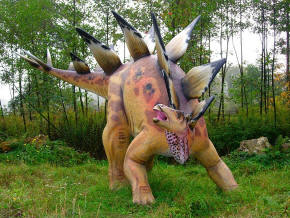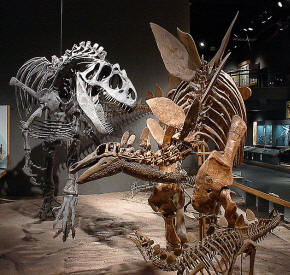|
Description
Stegosaurus
did have very short forelimbs, in relation to its hind legs. Furthermore,
within the hindlimbs, the lower section (comprising the
tibia and
fibula) was short
compared with the
femur. This suggests
that it couldn't walk very fast, as the stride of the back legs at speed
would have overtaken the front legs, giving a maximum speed of 67
kilometers per hour (45 mi/hr).
Tracks discovered by Matthew
Mossbrucker (Morrison Natural History Museum, Colorado) suggest that
Stegosaurus lived in
multi-age herds. One group of tracks is interpreted as showing four or five
baby stegosaurs moving in the same direction, while another has a juvenile
stegosaur track with an adult track overprinting it.
Stegosaurus may have
preferred drier settings than other common Morrison Formation dinosaurs,
such as
Allosaurus,
Apatosaurus,
Camarasaurus, and
Diplodocus.
Plates
The most recognizable features of
Stegosaurus are its
dermal plates, which consisted of 17
 |
| Model with modern spike arrangement, Bałtów Jurassic Park,
Poland. (Picture
Source) |
separate flat plates. These were highly
modified osteoderms (bony-cored
scales), similar to those seen in crocodiles and many lizards today. They
were not directly attached to the animal's skeleton, instead arising from
the skin. The largest plates were found over the animal's hips and measured
60 centimeters (2 ft) wide
and 60 centimeters tall.
One of the major subjects of books
and articles about Stegosaurus
is the plate arrangement. The argument has been a major one in the history
of dinosaur reconstruction. Four possible plate arrangements have been
mooted over the years:
 | The plates lay flat along the
back, as a
shingle-like armor.
This was Marsh's initial interpretation, which led to the name 'Roof
Lizard'. As further and complete plates were found, their form showed
that they stood on edge, rather than lying flat. |
 | By 1891, Marsh published a more
familiar view of Stegosaurus,
with a single row of plates. This was dropped fairly early on
(apparently because it was poorly understood how the plates were
embedded in the skin and it was thought that they would overlap too much
in this arrangement). It was revived, in somewhat modified form, in the
1980s, by an artist (Stephen Czerkas), based on the arrangement of
iguana dorsal
spines. |
 | The plates paired in a double
row along the back. This is probably the most common arrangement in
pictures, especially earlier ones (until the 'Dinosaur
Renaissance' in the '70s). (The
Stegosaurus in the
1933 film,
King Kong, has
this arrangement.) However, no two plates of identical size and shape
have ever been found within the same animal. |
 | Two rows of alternating plates.
By the early 1960s, this had become (and remains) the prevalent idea,
mainly because the one Stegosaurus stenops
fossil with the plates still articulated indicates this arrangement. An
objection to it is that this phenomenon is unknown among other reptiles
and it is difficult to understand how such a disparity could evolve. |
In the past, some palaeontologists,
notably
Robert Bakker, have
speculated the plates may have been mobile to some degree, although others
disagree. Bakker suggested that the plates were the bony cores of pointed
horn-covered plates that a Stegosaurus
could flip from one side to another in order to present a predator with an
array of spikes and blades that would impede it from closing sufficiently to
attack the Stegosaurus
effectively. The plates would naturally sag to the sides of the
Stegosaurus, the length of
the plates reflecting the width of the animal at that point along its spine.
His reasoning for these plates to be covered in horn is that the surface
fossilized plates have a resemblance to the bony cores of horns in other
animals known or thought to bear horns, and his reasoning for the plates to
be defensive in nature is that the plates had insufficient width for them to
stand erect easily in such a manner as to be useful in display without
continuous muscular effort.
The function of the plates has been
much debated. Initially thought of as some form of armor, they appear to
have been too fragile and ill-placed for defensive purposes, leaving the
animal's sides unprotected. More recently, researchers have proposed that
they may have helped to control the body temperature of the animal, in a
similar way to the sails of the large carnivorous
Spinosaurus or of the
pelycosaur
Dimetrodon (and the
ears of modern elephants and jackrabbits). The plates had blood vessels
running through grooves and air flowing around the plates would have cooled
the blood. Recent structural comparisons of
Stegosaurus plates to
Alligator osteoderms
seems to support the conclusion that the potential for a thermoregulatory
role in the plates of Stegosaurus
definitely exists. This theory has been seriously questioned, since its
closest relatives, such as Kentrosaurus,
had more low surface area spikes
than plates, implying that cooling was not important enough to require
specialized structural formations such as plates.
Their large size suggests that the
plates may have served to increase the apparent height of the animal, in
order either to intimidate enemies or to impress other members of the same
species, in some form of sexual display, although both
male and female specimens seemed to have had them. It has been suggested
that, in addition to looking bigger,
Stegosaurus pumped blood into its plates causing
them to "blush"
which would add to the visual threat display. A study published in 2005
supports the idea of their use in identification. Researchers believe this
may be the function of other unique anatomical features, found in various
dinosaur species. Stegosaurus stenops
also had disk-shaped plates on its hips.
Thagomizer (tail spikes)
There has been debate about whether
the tail spikes were used for display only, as posited by Gilmore in 1914 or
used as a weapon. Robert Bakker noted the tail was likely to have been much
more flexible than that of other dinosaurs, as it lacked ossified tendons,
thus lending credence to the idea of the tail as a weapon. However, as
Carpenter has noted, the plates overlap so many tail vertebrae, that
movement would be limited. Bakker also observed that
Stegosaurus could have
maneuvered its rear easily, by keeping its large hindlimbs stationary and
pushing off with its very powerfully muscled but short forelimbs, allowing
it to swivel deftly to deal with attack. More recently, a study of tail
spikes by McWhinney et al.,
which showed a high incidence of trauma-related damage, lends more weight to
the position that the spikes were indeed used in combat. Additional support
for this idea was a punctured tail vertebra of
Allosaurus into which a tail spike fit
perfectly.
Stegosaurus stenops
had four dermal spikes, each about 6090 centimeters (23 ft) long.
Discoveries of articulated stegosaur armor show that, at least in some
species, these spikes protruded horizontally from the tail, not vertically
as is often depicted. Initially, Marsh described
S. armatus as having eight
spikes in its tail, unlike S. stenops.
However, recent research re-examined this and concluded this species also
had four.
"Second
brain"
Soon after describing
Stegosaurus, Marsh noted a
large canal in the hip region of the spinal cord, which could have
accommodated a structure up to 20 times larger than the brain. This has led
to the famous idea that dinosaurs like
Stegosaurus had a 'second brain' in the tail,
which may have been responsible for controlling reflexes in the rear portion
of the body. It has also been suggested that this "brain" might have given a
Stegosaurus a
temporary boost when it was under threat from predators. More recently, it
has been argued that this space (also found in sauropods) may have
been the location of a
glycogen body, a
structure in living birds whose function is not definitely known but which
is postulated to facilitate the supply of
glycogen to the
animal's nervous system.
Diet
Stegosaurus
and related genera were herbivores. However, they adopted a feeding strategy
different from that of the other herbivorous ornithischian
dinosaurs. The other ornithischians possessed teeth capable of grinding
plant material and a jaw structure capable of movements in planes other than
simply orthal (i.e. they could chew plants). This contrasts with
Stegosaurus (and all
stegosaurians), which had small teeth having horizontal wear facets
associated with tooth-food contact and a jaw probably capable of only orthal
movements.
The stegosaurians must have been
successful, as they became speciose and geographically widely distributed,
in the late Jurassic. Palaeontologists believe it would have eaten plants
such as mosses, ferns, horsetails, cycads and conifers or fruits and
swallowed
gastroliths to aid food
processing (due to the lack of chewing ability), in the same manner used by
modern birds and crocodiles. Low-level browsing on grasses, seen in modern
mammalian herbivores, would not have been possible for
Stegosaurus, as grasses
did not evolve until late into the Cretaceous Period, long after
Stegosaurus had become
extinct.
One hypothesised feeding behavior
strategy considers them to be low-level browsers, eating low-growing fruit
of various non-flowering plants, as well as foliage. This scenario has
Stegosaurus
foraging at most one meter above the ground. On the other hand, if
Stegosaurus could have
raised itself on two legs, as suggested by Bakker, then it could have
browsed on vegetation and fruits quite high up, with adults being able to
forage up to 6 meters (20 ft) above the ground.
A detailed computer analysis of the
biomechanics of Stegosaurus's
feeding behavior was performed in 2010, using two different
three-dimensional models of Stegosaurus
teeth given realistic physics and properties. Bite force was also calculated
using these models and the known skull proportions of the animal as well as
simulated tree branches of different size and hardness. The resultant bite
forces calculated for Stegosaurus
were 140.1 N, 183.7 N, and 275 N (for anterior, middle and posterior teeth,
respectively), which means that its bite force was less than half that of a
Labrador retriever. This indicates that
Stegosaurus could have easily bitten through
smaller green branches, but would have had difficulty with anything over 12
mm in diameter. Stegosaurus
therefore probably browsed primarily among smaller twigs and foliage, and
would have been unable to handle larger plant parts unless the animal was
capable of biting much more efficiently than predicted in this study.
Popular culture
One of the most recognizable of all
dinosaurs, Stegosaurus
has been depicted on film, in cartoons, comics, as children's toys, and was
even declared the
State Dinosaur of
Colorado in 1982.
To learn more, see the Wikipedia article
Stegosaurus in popular culture.
Return to the
Old Earth Ministries Online Dinosaur
Curriculum homepage.

|

